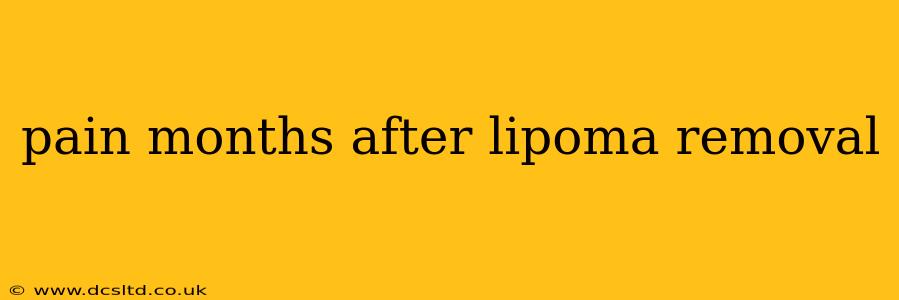Lipoma removal is a relatively common procedure, but experiencing pain months after the surgery can be concerning. While most discomfort subsides within a few weeks, persistent pain warrants attention. This comprehensive guide explores the potential causes of lingering pain after lipoma removal, offering insights and advice to help you understand and manage your experience.
What is a Lipoma?
Before diving into post-surgical pain, let's briefly define lipomas. A lipoma is a benign (non-cancerous) fatty tumor that grows just beneath the skin. They are usually soft, movable, and painless. While most lipomas require no treatment, they are often removed surgically for cosmetic reasons or if they cause discomfort or interfere with movement.
Why Do I Still Have Pain Months After Lipoma Removal?
Several factors can contribute to persistent pain months after lipoma removal:
1. Nerve Damage:
During lipoma excision, there's a possibility of minor nerve damage. This can lead to ongoing pain, numbness, tingling, or hypersensitivity in the affected area. The severity depends on the location and size of the lipoma and the surgical technique. In some cases, this nerve damage can take months to fully heal.
2. Scar Tissue Formation:
Scar tissue is a natural part of the healing process. However, excessive or poorly formed scar tissue can adhere to surrounding nerves and tissues, causing pain, tightness, and restricted movement. This is particularly relevant if the lipoma was large or located in an area with limited mobility.
3. Infection:
Although less common, a persistent infection at the surgical site can lead to chronic pain and inflammation. Signs of infection might include increased redness, swelling, warmth, pus, or fever. If you suspect an infection, seeking immediate medical attention is crucial.
4. Incomplete Lipoma Removal:
In rare instances, fragments of the lipoma might remain after surgery. This can result in recurring growth and persistent pain.
5. Underlying Medical Conditions:
In some cases, persistent pain might be unrelated to the lipoma removal itself. Pre-existing conditions like fibromyalgia or chronic pain syndromes could be exacerbated by the surgery, leading to prolonged discomfort.
How Long Does Pain After Lipoma Removal Usually Last?
The duration of post-surgical pain varies greatly depending on individual factors. Most patients experience mild discomfort for a few days to a few weeks. However, significant pain lasting several months suggests an underlying issue requiring medical attention.
What Should I Do if I'm Still in Pain Months After Lipoma Removal?
If you're experiencing persistent pain, don't hesitate to contact your surgeon or doctor. They can perform a thorough examination, rule out complications, and recommend appropriate treatment. This might include:
- Pain management medication: Over-the-counter pain relievers or prescription medications may help manage pain.
- Physical therapy: Physical therapy can help improve range of motion, reduce scar tissue, and alleviate pain.
- Steroid injections: Injections of corticosteroids can help reduce inflammation and pain.
- Further surgical intervention: In rare cases, additional surgery might be necessary to address incomplete lipoma removal or manage scar tissue.
Are There Any Home Remedies That Can Help?
While home remedies can't replace professional medical advice, certain measures can help manage mild pain and discomfort:
- Applying ice packs: Ice can help reduce swelling and inflammation.
- Gentle massage: Once the wound has healed, gentle massage can help soften scar tissue.
- Over-the-counter pain relief: Ibuprofen or acetaminophen can provide temporary pain relief.
- Rest and elevation: Allowing the area to rest and elevating it can aid in healing.
When Should I Seek Immediate Medical Attention?
Seek immediate medical help if you experience:
- Signs of infection (increased redness, swelling, warmth, pus, fever)
- Severe or worsening pain
- Numbness or tingling that extends beyond the surgical site
- Inability to move the affected area
Remember, persistent pain months after lipoma removal is not normal. Consulting a medical professional is crucial to identify the cause and receive appropriate treatment. Don't suffer in silence – proactive medical attention can significantly improve your recovery and quality of life.
